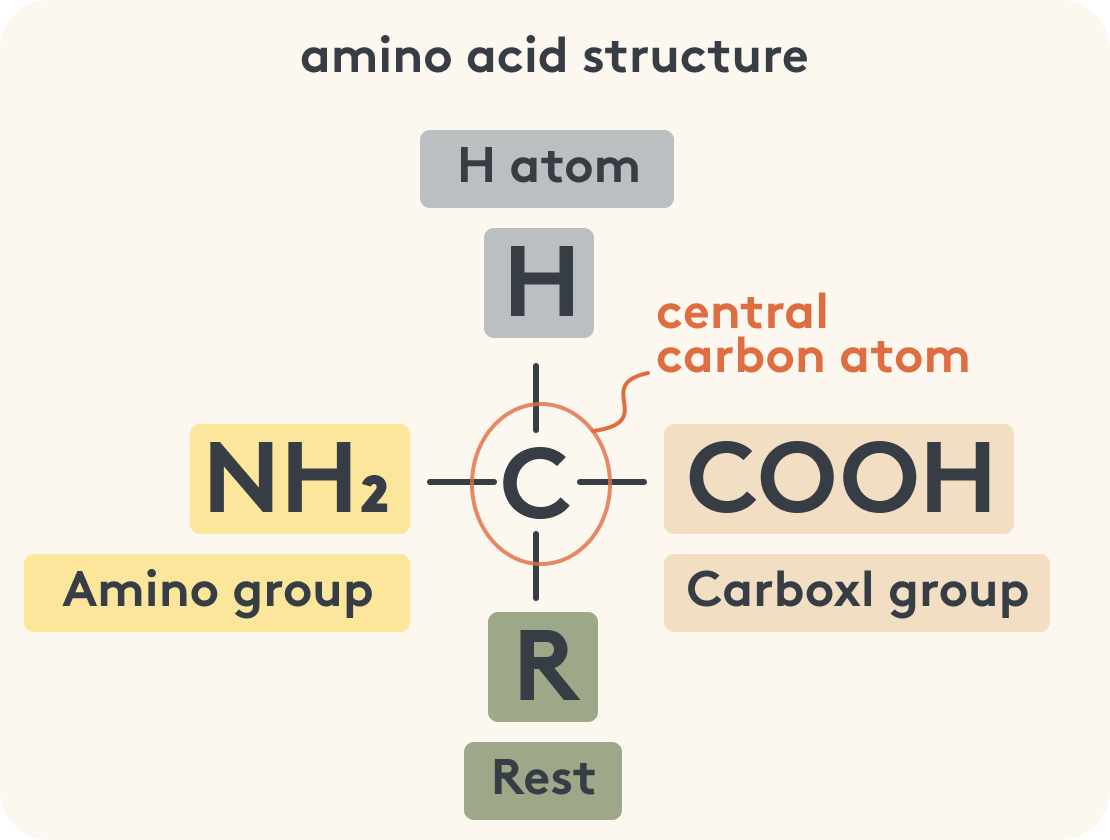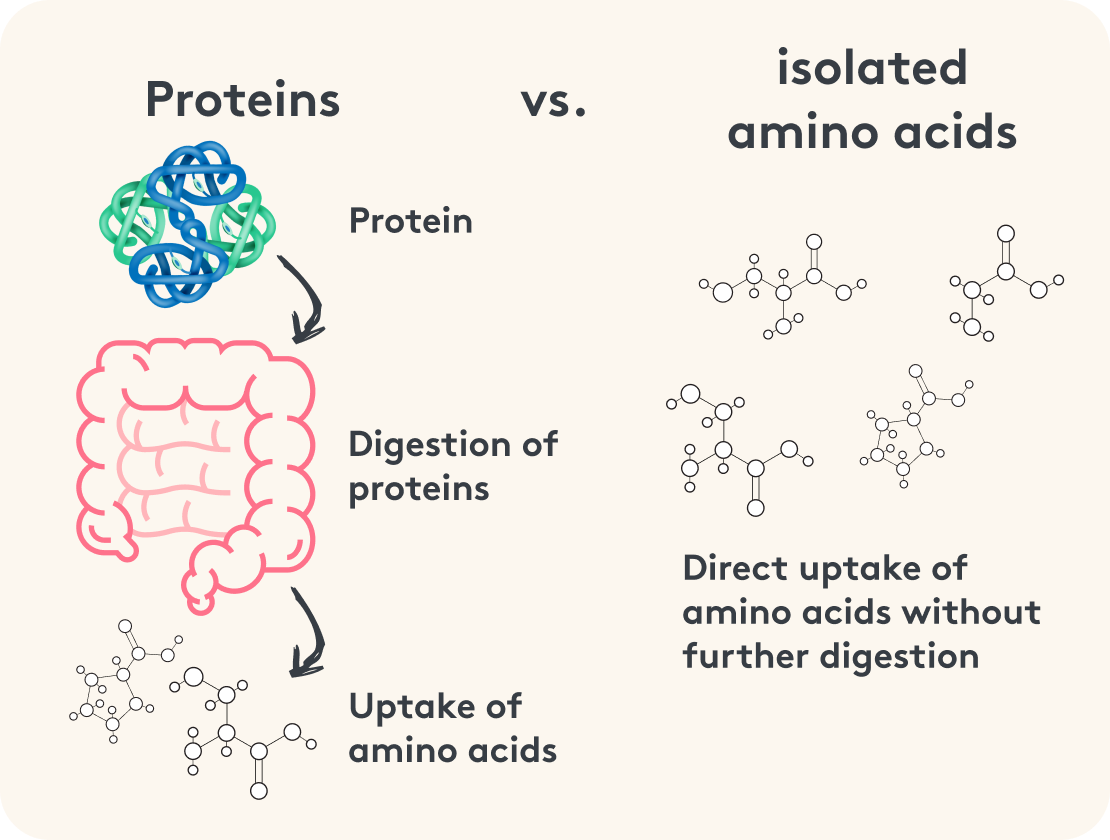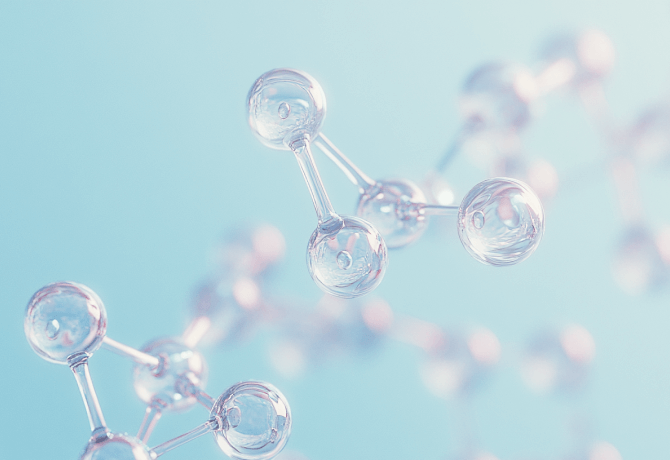Themen dieses Blogartikels:
Table of Contents
- Explained simply: What are amino acids?
- What amino acids are there?
- Structure of amino acids
- Why do amino acids & sport belong together?
- Other reasons why amino acids in particular are so important for sport
- How do I provide my body with amino acids?
- Using proteins as a source of amino acids
- What is the biological value?
- Absorb isolated amino acids
- Which amino acid product is right for me?
- Taking BCAA
- Absorb amino acids individually
- When is the best time to take amino acids?
- Tip: Support regeneration with amino acids
- Bibliography
Explained simply: What are amino acids?
Amino acids are organic compounds. They are also known as the “building blocks of life”, as they form the basis for proteins and enzymes and are involved in various metabolic processes. They also help to maintain and build muscles. Their effect on your performance during training should therefore not be underestimated.
What amino acids are there?
A distinction is made between proteinogenic and non-proteinogenic amino acids:
- Proteinogenic amino acids are necessary for the formation of proteins. The body needs them to survive
- Non-proteinogenic amino acids, on the other hand, are not found in proteins. Nevertheless, they fulfill important functions, such as the neurotransmitter GABA (gamma-aminobutyric acid). It is one of the muscle-building hormones and is important for strength athletes
Proteinogenic amino acids are divided into essential (essential amino acid, EAA) and non-essential amino acids: essential means that your body cannot produce these amino acids itself and must therefore absorb them through food
- From these essential amino acids, among others, the body can then produce non-essential amino acids on its own
- There are no precise guidelines as to what quantities of individual essential amino acids you should consume.
Structure of amino acids
Amino acids consist of a central carbon atom. Four elements are arranged around this atom:
- an amino group with nitrogena
- carboxyl group
- a hydrogen atom and an amino acid residue, also known as a side chain
The rest determines the properties of an amino acid.


Why do amino acids & sport belong together?
To understand why amino acids are so important for sport, we only need to look at what muscles are made of: The largest proportion of muscles is water (75 percent), 20 percent of the dry mass consists of proteins and the rest is made up of fats, among other things.
When you exercise, the tissue of the muscles is stressed. Amino acids play an important role in regeneration after training: they repair small tears in the muscle fibers and help to make damaged proteins fit again or form new ones.
Other reasons why amino acids in particular are so important for sport
- Arginine, glycine and methionine are necessary for the synthesis of creatine. Creatine is a substance that contributes to the supply of energy in the muscle during exercise and ensures that the contraction can be maintained for longer - without starting anaerobic energy production
- Taurine is a non-proteinogenic amino acid that influences energy metabolism in fat and muscle cells1
- The branched-chain amino acids leucine, isoleucine and valine are often recommended for weight training: These so-called Branched-Chain Amino Acids (BCAA) can be oxidized and serve as an energy source in muscle tissue. During physical activity, this oxidation is promoted to a greater extent, while at the same time the administration of BCAA inhibits the breakdown of muscle protein2
- L-carnitine is a non-proteinogenic amino acid that is responsible for the transport of fatty acids into the mitochondria. The muscles do not produce L-carnitine themselves, but must absorb the amino acid from the blood. During physical work, the demand in muscle tissue is increased, especially during prolonged exercise when fat burning is particularly active3
- Tyrosine and phenylalanine are precursors of neurotransmitters and the hormones adrenaline, noradrenaline and dopamine - these performance hormones are important for activity and concentration
- Glutamine is not only a component of proteins, but may even play a role in regeneration - recent studies show that glutamine can accelerate regeneration and the resolution of inflammation in damaged, regenerating muscles4
- Arginine and citrulline are substrates of the so-called eNOS. These enzymes produce the vasodilator NO. Vasodilatation, i.e. vasodilation, prevents an excessive increase in blood pressure and at the same time promotes blood flow5; both can be important for athletes
Amino acids have a variety of functions from which your muscles can benefit. These range from supporting regeneration and providing energy to increasing blood flow.
How do I provide my body with amino acids?
Do you want to benefit from all these advantages during strength training or endurance sports? In principle, there are two ways to supply your body with amino acids - either through proteins or in isolation. You can now find out what this means and which option is better.
Using proteins as a source of amino acids
You automatically absorb amino acids with your food by eating proteins. These are broken down into individual amino acids in your digestive system and then absorbed by the intestinal cells and released into the blood. Pulses, white meat, fish, but also dairy products and eggs contain protein and should have a fixed place in the diet of athletes.
What is the biological value?
How well the protein is absorbed depends on the biological value of the protein and how well it is digested. The biological value describes how well a protein can be absorbed. This value is increased by an optimal ratio of the individual essential amino acids to each other - although this ratio is not usually ideal. Vegetable protein, for example, often contains too little methionine and cysteine. It therefore makes sense to combine different proteins in any case.


Absorb isolated amino acids
Food supplements offer you the opportunity to take amino acids individually. If dietary supplements are an option for you, there are various preparations to choose from:
- individual amino acids (for example L-glutamine)
- BCAA only
- essential amino acids or other more specialized mixtures
The advantage over protein intake: The body can better utilize aminos in free form, as they do not first have to be broken down and made available in the digestive tract.
Of course, a sufficient supply of protein via dairy products and other protein-containing foods is important for covering your amino acid requirements. However, especially in sports, it can be useful to also use isolated amino acids to optimally support your workout, leaving the question of which amino acid product is suitable and whether it is better to take amino acids before a workout, during training or afterwards.
Which amino acid product is right for me?
Single aminos, BCAA, EAA - the choice is huge. However, the question of which product is right for you is not that difficult to answer: In the vast majority of cases, it makes sense to take all essential amino acids, as they contain both BCAA and all other necessary amino acids.
Taking BCAA
BCAA prove to be helpful when training would jeopardize muscle mass, i.e. when muscle breakdown would occur. Here, BCAA can help to inhibit muscle breakdown, as the body can use the supplemented amino acids as an energy source. It is rather rare that the BCAA content in an amino acid complex with all essential amino acids is insufficient.
Absorb amino acids individually
Individual amino acids are only of limited help - at least if only one amino acid is supplemented via food supplements. Your body is of no use if it is overwhelmed with L-arginine, for example, but lacks all other essential amino acids. The situation is different if you take individual amino acids in addition to the essential amino acids, perhaps even in a combined amino acid complex.
You can find the right amino acid products for your sporting needs at MITOcare.
When is the best time to take amino acids?
Once you have decided on your amino acid product, the question remains as to when you should best plan your intake. We recommend that you take your amino acids at least half an hour after training and at least half an hour after eating.
The reason: this allows your body to absorb the free amino acids better. After a training session, blood circulation is also increased and the need for regeneration is greater - the amino acids therefore reach their target faster and can take effect.
Tip: Support regeneration with amino acids
You can take amino acids before going to bed so that your body can recover even better during sleep and you wake up feeling rested in the morning. For example, you can take MITOcare's amino acids half an hour before you turn out the light. As a precursor to melatonin, the sleep hormone, the tryptophan it contains can help you fall asleep.
Want to know how melatonin affects your sleep and how you can finally sleep better? In our sleep blog for restful nights, the most important facts and everyday tips await you.
This article is based on carefully researched sources:
Bibliography
- Wen, C., Li, F., Zhang, L. et al. (2019). Taurine is Involved in Energy Metabolism in Muscles, Adipose Tissue, and the Liver. Molecular nutrition & food research, 63(2), e1800536. doi.org/10.1002/mnfr.201800536
- Shimomura, Y., Murakami, T., Nakai, N. et al. (2004). Exercise promotes BCAA catabolism: effects of BCAA supplementation on skeletal muscle during exercise. The Journal of nutrition, 134(6 Suppl), 1583S–1587S. doi.org/10.1093/jn/134.6.1583S
- Gnoni, A., Longo, S., Gnoni, GV et al. (2020). Carnitine in Human Muscle Bioenergetics: Can Carnitine Supplementation Improve Physical Exercise?. Molecules (Basel, Switzerland), 25(1), 182. doi.org/10.3390/molecules25010182
- Koike TE, Dell Aquila RA, Silva KS et al. (2022). Glutamine supplementation improves contractile function of regenerating soleus muscles from rats. Journal of muscle research and cell motility, 43(2), 87–97. doi.org/10.1007/s10974-022-09615-3
- Khalaf, D., Krüger, M., Wehland, M. et al. (2019). The Effects of Oral l-Arginine and l-Citrulline Supplementation on Blood Pressure. Nutrients, 11(7), 1679. doi.org/10.3390/nu11071679













